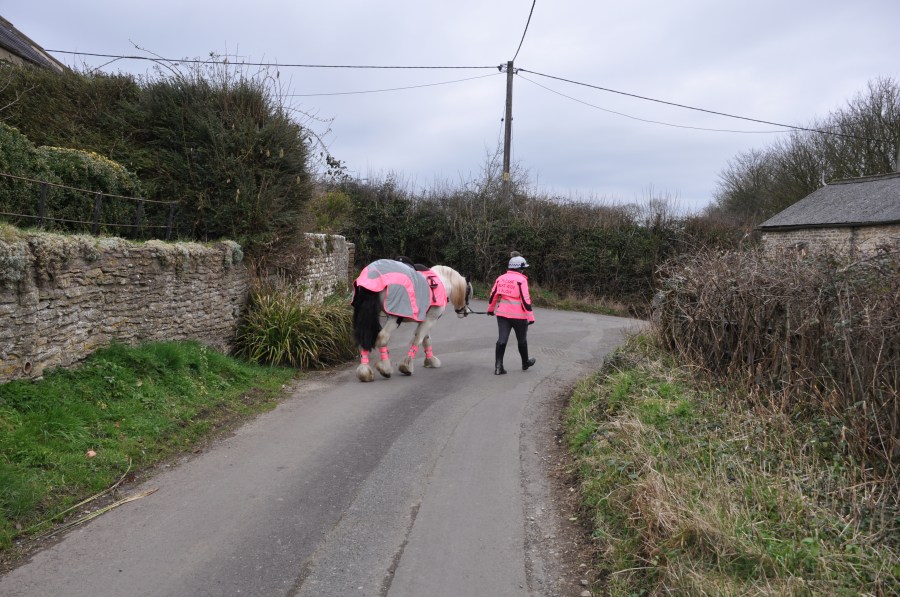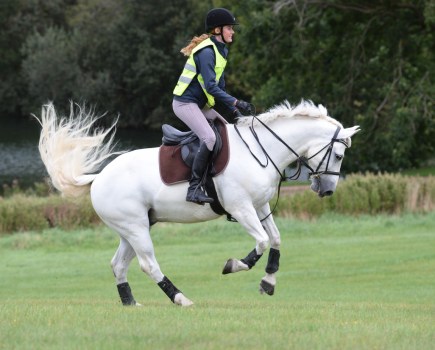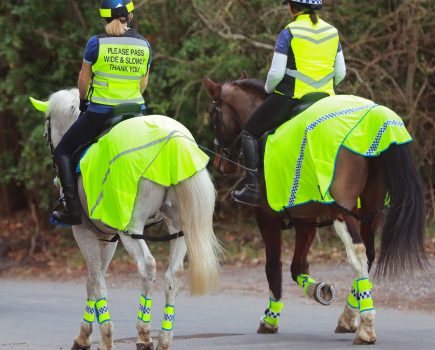In partnership with Equisafety
Imagine you’re out hacking a horse along a quiet country lane and they suddenly grind to a halt, refusing to move forward or napping backwards. The last time this happened to me, my ex-racehorse had spotted a washing line blowing in a back garden and he had no idea what it was. Turning around wasn’t an option; it was a quiet road and he stood there stock still for a good few minutes before he would move forward again. Presumably having worked out that the clothes were not going to eat him.
He wasn’t a horse for whom napping was typical behaviour. That day, he simply saw something that he had no idea what it was and he needed time to work it out. This is just one example of what a horse napping out hacking might look like. Some will refuse to leave the yard completely; others might go as far as a certain point and then start napping and hanging for home rather than continuing forward. Or they might nap towards horses loose in a field as they ride past. There are lots of potential causes for a horse napping out hacking, and as a rider it isn’t much fun. Luckily, it is a problem that can usually be fixed.
Why is a horse napping out hacking?
“Horses will nap if they’re not having a nice time, so introducing a praise and reward system will help to improve your levels of control, as well as your horse’s behaviour,” says esteemed coach and former 5* event rider Caroline Moore. “This simply involves rewarding your horse with a pat or a treat when they do what you ask of them, so they start to associate these things with a reward.
“Napping can also occur as a result of your horse trying to avoid something. They learn to nap and then use this behaviour in situations to get out of doing something they don’t want to do. A clever horse will nap by a fence or hedge line and simply back into it. They’ll have learned that you have to take your leg pressure off or end up in the hedge.”
Introducing a horse to hacking correctly is the best way to eliminate napping. By making sure it’s a positive experience, they’ll want to do it again. If it’s a poor experience or they have a fright, they may lose confidence and this can lead to a horse napping out hacking.
“When first introducing your horse to hacking, make sure it’s a positive experience,” confirms Caroline. “If you’re asking them to walk through traffic, have another horse with you so they feel safe in their company.”
This applies whether you’re riding a young horse hacking out for the first time, a new horse you’ve just started riding or a horse who has not been hacking for a while, perhaps because they’ve been injured or turned away. Make the first hack a great one, ideally with another more experienced horse and rider to keep them company and give your confidence, and build from there.
What does a horse napping out hacking look like?
Napping is when a horse refuses to move in the direction you want to go. It can start as planting, but can escalate to backing up, spinning, bucking and even rearing. For many riders, it’s a difficult and nerve-wracking behaviour to deal with, particularly out hacking, but it is possible to address through training. The best place to start is by identifying the potential causes for your horse napping, which include:
- Pain
- Confusion over the rider’s aids
- Separation anxiety (they’ve left their friends in the field at home)
- Lack of confidence (maybe they haven’t done a lot of hacking before or they can feel that their rider is nervous on top)
Rule out pain
Before tackling any behavioural issue, such as napping, through training, you must first rule out pain as the cause. Have your saddle checked by a saddle fitter, as well as your other tack including your bridle and bit. Book an appointment with your vet to rule out any potential physical issues, such as lameness, gastric ulcers or orthopaedic issues such as kissing spines or arthritis, which could cause pain when ridden. You might also want to consider booking an appointment with a physiotherapist, chiropractor, or other paraprofessional for additional support.
Once pain has been completely ruled out, you can begin re-training your horse.
Refine your aids
The first thing to do is refine your aids. You don’t want to get into the habit of nagging your horse to go forwards — you need them to be responsive to your leg. With a slow or lazy horse it can be tempting to kick or squeeze their sides repeatedly to keep them moving. However, can actually switch them off from your leg and they start to ignore this. This means that when you do need to get them to go, they no longer respond to your leg aids.
Address this by re-training your horse to be more sensitive to your leg aids. Whether you are schooling at home or out hacking, make sure you keep a quiet leg when they are moving forward. Ask them to halt, and then move on again. Focus on using the quietest leg aids you can, and as soon as they move, stop applying them. Gradually you can build up to asking them to step with more purpose or speed. Again, don’t nag constantly. As soon as you get your desired response, stop applying the aids.
If it’s not working and you’re not getting the forward walk you want, it is better to follow up your initial leg aid with a firmer leg aid, rather than keeping on at your horse with lots of little ones. It could be that you then need to back up the firmer leg aid with a flick of your whip behind the saddle. You won’t have to do this many times. If you’re consistent with your aids and only accept a forward walk, your horse will quickly learn to respond to the first time you ask for it.
Is it separation anxiety?
Horses are social animals and they form strong bonds with their equine friends, so it’s not a surprise that they can feel anxious when asked to leave them. Overcoming this takes time. It’s important not to rush and to treat it holistically. Getting them to go for a hack on their own without napping is not a quick fix; it’s about making them feel more confident to leave their friend.
The best place to start is by addressing the problem from the ground. Take time to do activities with your horse that will build your relationship, such as grooming, groundwork and hacking in-hand, will help enormously. Once your horse is happy on the ground, move on to riding and gradually hacking. Introduce each step in the smallest increment as possible; doing too much too soon can slow down progress. In the meantime, though, you could build on your horse’s hacking confidence by riding them out in groups and giving them a friend to follow.
Spend time building confidence
Some horses might nap if they are shy or spooky and don’t want to go past something that is worrisome.
“The best way to deal with your horse if they’re already spooking or napping out hacking is in the safety of an arena or field,” says Caroline Moore. “You can set up obstacles to ride around, past and over, leg-yielding past anything they find scary, with the horse’s head bent away from it.”
Try this exercise from Eloise Mayhead, stable manager at the City of London’s Mounted Police Branch, to give your horse the skills they need to pass something scary. Once you’ve mastered it in the arena, you can do it out on hacks. Generally speaking, if you find yourself struggling with a horse napping out hacking and you aren’t sure of the root cause or how best to handle it, seek advice and guidance from a professional.
This content is brought to you in partnership with Equisafety, high viz clothing for horses and riders and proud sponsor of Your Horse’s #Hack1000Miles.









